The trip from Istanbul to Munich and then on to Madrid went well, but there were big distances to be walked in both terminals and a surprising number of flights using a bus and stairs to the plane, either boarding or de-planing. We flew over the Pyrenees but there was really no snow on the mountains we saw. There was a long walk at Madrid to get to the car hire which was only available at terminal 1; a Seat car, diesel which we prefer, and roomy enough for us and our luggage.
Off to Toledo and some difficulty finding our accommodation as the GPS preferred to send us to a Carmelite convent rather than our planned Hostal del Cardenal. With a bit of help from the locals we eventually found it, a green oasis behind high walls with multiple sets of stairs and no elevator. We must have been seduced by the look of this place when booking because we are usually very careful about this. However, a more gradual ramp around the walls was discovered and that helped considerably, plus we “encouraged” the staff to rescue our luggage from the car.
 Hotel stairs, oops! | 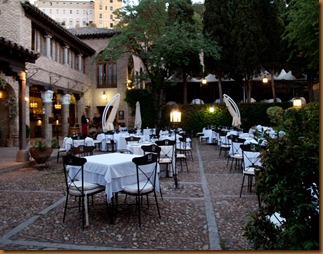
The lovely terrace where we ate our tiny piggy |
Now Toledo is built on seven hills. Again, what were we thinking??? But it is so lovely; full of history, amazing architecture, art and restaurants (all serving roast piggy quarters). We wandered a bit that evening, then ate roast piggy in the garden of the hotel. And very nice it was too!
The next morning we drove to the top of the hill to near the forbidding Alcazar and parked, from there moving gradually downhill to the cathedral and later on to the El Greco museum. We didn’t visit the Alcazar as that is a military museum and they really don’t appeal to us. Of course, at the end, we needed to take a taxi back to the parking at the top of the hill.
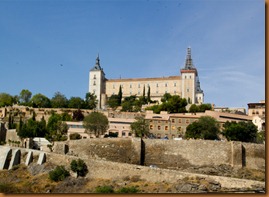
Alcazar | 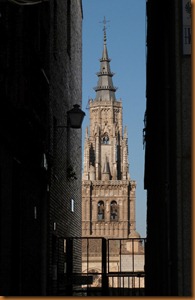
A glimpse of the cathedral spire | 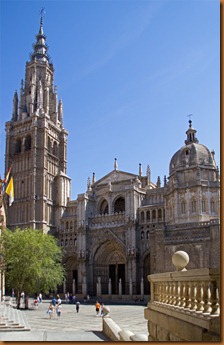
Cathedral and square | 
Massive city gate |
The cathedral was the second biggest in Spain, but somehow formidable. The altar, enclosed by a grille is quite close to the double choir, also enclosed, so there is a feeling of exclusion, even though the cathedral was large enough to take the entire population inside at one time.

Cathedral and square | 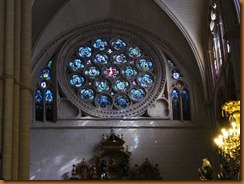
One of the rose windows | 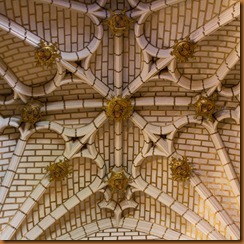
Beautiful vaulting | 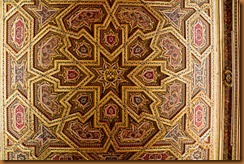
Arabic ceiling in a side chapel |
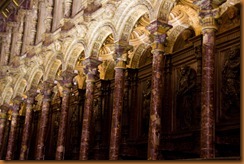
The second tier of choir seats | 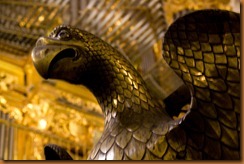
The very annoyed looking eagle on the choir lectern | 
A royal tomb in a side chapel | 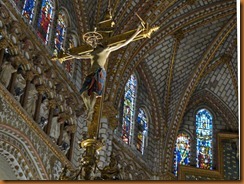
A rather beautiful crucifix |
More than the architecture, it was the art that grabbed us. In small rooms the walls were hung with the likes of Caravaggio, El Greco, Rubens, Van Dyck, Tintoretto and so on. Most people just walked past, oblivious.
One section, in the rear of the ambulatory behind the altar houses Il Transparente, so named because it allows light to come in through an opening and shine through an amazingly baroque marble and bronze arrangement of saints and angels, to transmit some light to the high altar.
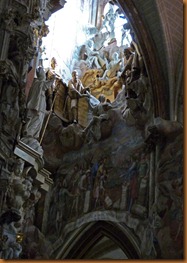
The highly decorated window | The marble and bronze confection
|
We walked quite a bit to search for the El Greco house and museum. One man had a vision to display his art and his working environment together, and though it wasn’t really El Greco’s house he did have one close by. Apparently this idea for showcasing an artist was novel in its day and much adopted by others. Personally, if any artist was ever so tidy that not a brush or paint tube was visible in his studio I would be very surprised, but the house was quite interesting.
The art work was stupendous. A second series of portraits of the twelve apostles (the other is in the cathedral) was the highlight for us. He really gave them personality.
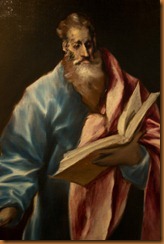
St Mark | 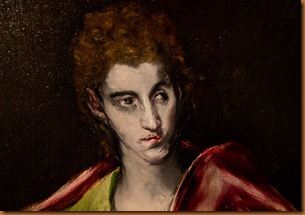
St John (looking just like a rebellious teenager) |
Toledo is defended by high walls and steep gorges leading to the river Tagus. Pretty, old bridges span the water and roads on the far side of the gorges ring the town, leading to wonderful views. We took advantage of a small tourist train to see this and get an overview of all the buildings.
Afterwards, we headed for the monastery of San Juan de los Reyes with a very beautiful double height cloister and an ornate chapel. This was to be the burial place of kings, but they ended up using Granada instead.
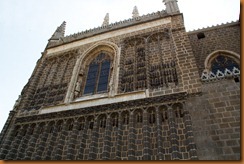
Chains adorn the outside, supposedly the chains that Muslims used to imprison Christian soldiers. Like I would carry my chains home in my luggage? | 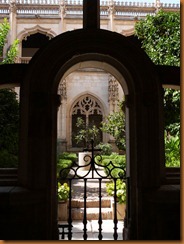
Entrance to cloister garden | 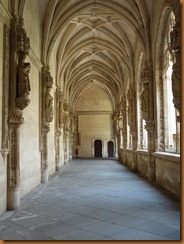
The luminous cloister. We have no idea re the big and little doors at the far end, the smaller being child sized | 
Sunlight streams in |
I was most taken by the gargoyles at the upper cloister level, an owl, a cat, an acrobat with his legs providing the water channel, fanciful beasts. In addition, I loved the vistas down the cloister, with its ornate wood roof in the arab style.
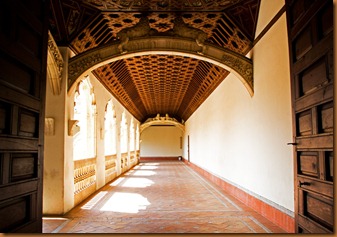
Upper cloister | 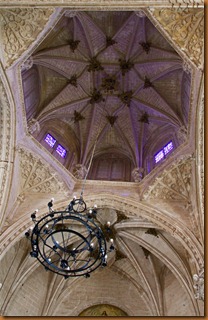
Stair ceiling and light |
We visited also the synagogue, curious as to how it could be named Santa Maria la Blanca. Oh, surprise, it had been taken over as a church! Now the walls had a pious letter from the bishop (and primate of Spain) saying how the Catholics love the Jewish people and may this art display symbolise peace. Given that Toledo prides itself on being the city of three cultures, Jewish, Islamic and Christian, I was actually quite offended that a former synagogue should still be named as a church, albeit not, it seems, a working one. The internal architecture was beautiful, though it reminded me more of a mosque than a synagogue.
Back to the hotel by bus to recuperate and pack for our move to Segovia in the morning, via the huge El Escorial.
Next episode: El Escorial and Segovia















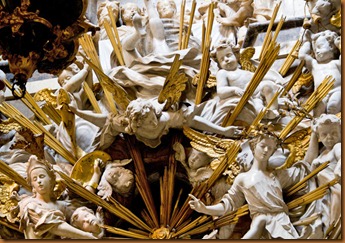



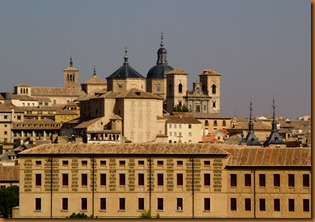





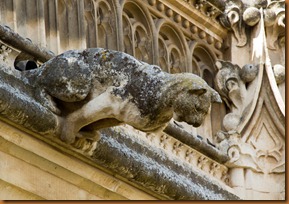

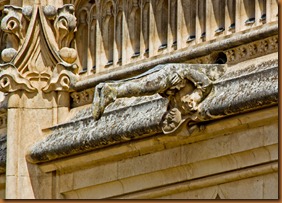


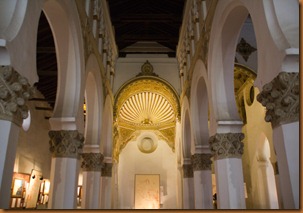

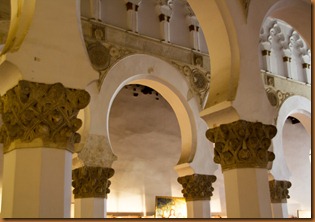
No comments:
Post a Comment